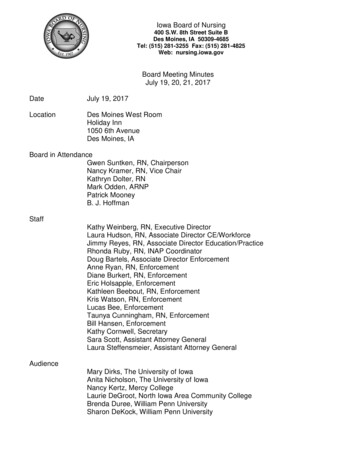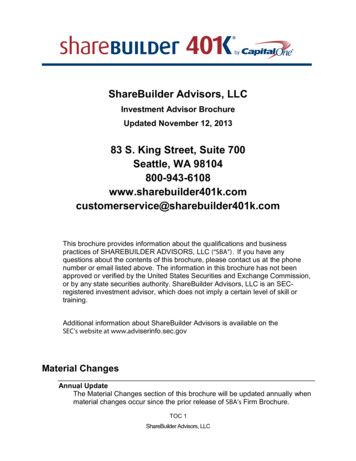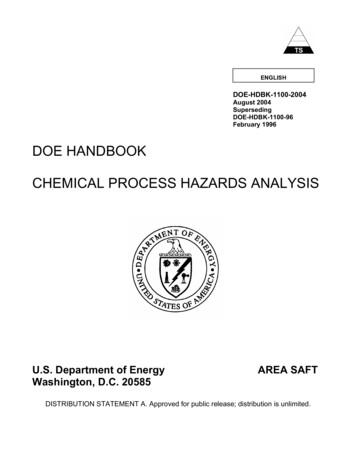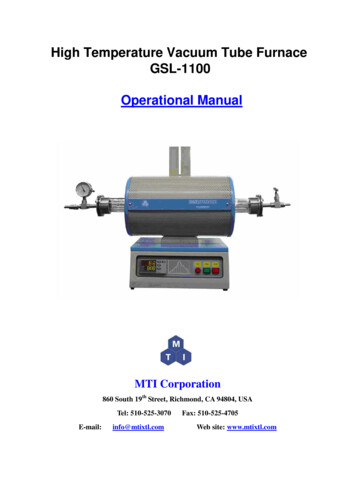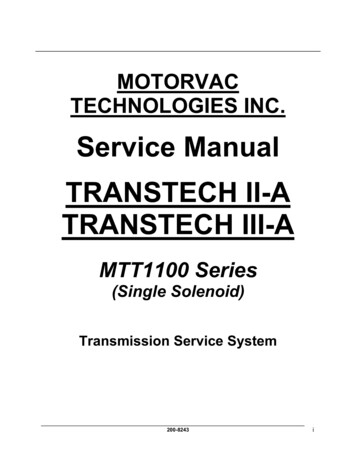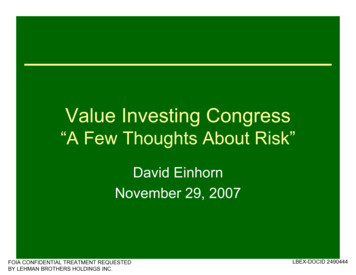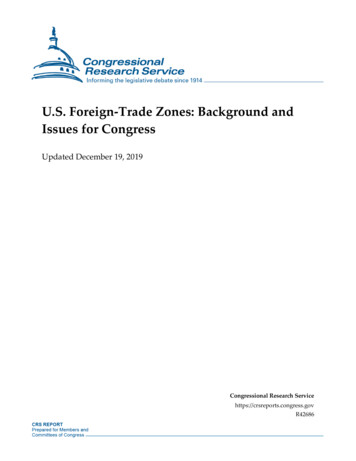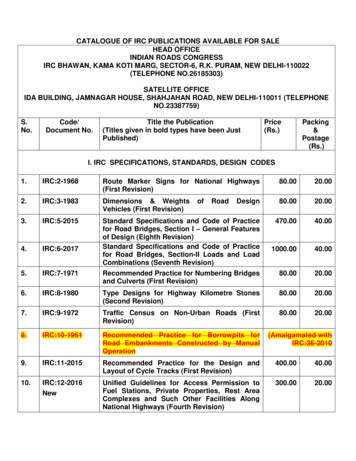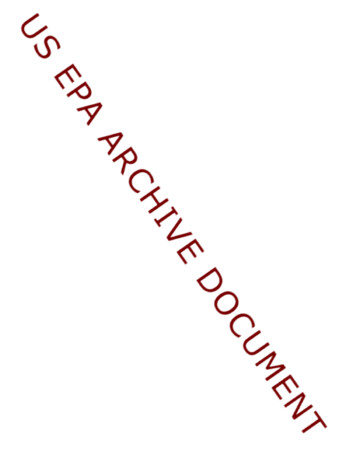
Transcription
EPA 901-F-04001April 20041 Congress Street, Suite 1100 SPPBoston, MA 02114-2023EPA New England- Hospital Environmental Assessment TemplateAn environmental compliance and pollution prevention toolIntroductionThis tool was developed for an Office of Environmental Compliance and Assistance (OECA) grant which was given to the Universityof New Hampshire Pollution Prevention Program. The tool was modified into three state specific tools for CT, RI and NH. Theinterns collected and compiled information from a total of 25 hospitals in the three states. A copy of the final report can be found athttp://www.unh.edu/p2/nhppp/i2003.html. This tool is not all-inclusive and it does not include all Federal hospital requirements orpreferable practices. If you are a VA there are additional requirements that will apply to you that are not covered in this template. Inaddition, you should also always check with your state for any additional state requirements. If you would like a word version of thisdocument to customize for your state or EPA Region, please email Janet Bowen of EPA Region I at Bowen.Janet@epa .gov or call herdirectly at (617) 918-1795.Section I: General Facility1.1Number of Hospital Beds:1.2What state are you located in?1.3What department(s) are responsible for environmental compliance at your hospital? (Check all that apply)Health and SafetyMaintenance/FacilityIndustrial HygienistEnvironmentalNursingOther (Specify)1.41.5 7575-200 200Has your hospital used EPA technical resources? (Check all that apply)Accessed H2E websiteParticipate on H2E ListservParticipate H2E teleconferencesParticipate EnergyStar internet trainingH2E fact sheetsH2E Assessment3/21/01 Hospital workshop in CTEPA presentationAccessed Region I website11/6/02 SPCC training in CTSPCC Amendment fact sheetEPCRA fact sheetTelephone assistance from EPAInformation from EPA at eventAccessed EPA websiteEnergyStar Benchmarking informationMercury Challenge Partners directoryOther (Specify)What changes or actions (if any) have you made as a result of EPA/H2E assistance? (Check all that apply)Filed notificationBecame H2E PartnerImproved/evaluated waterObtained permitInventoried mercury use/equipmentefficiencyProvided employee trainingBenchmarked/increase energy efficiency Reduced/replaced mercury itemsSubmitted documentation to EPA/StateMinimized infectious wasteInstituted/increased recycling/reuseAdopted formal purchasing policyCame into complianceOther (Specify)Section II: Compliance Self Assessment1.0 Resource Conservation and Recovery Act (RCRA) (40 CFR 261, 262, 265)1.1What is your hospital’s generator status? (Please check)No Hazardous Waste CESQG1 SQG21.2Does your hospital have an EPA hazardous waste generator number?1.3StorageIs all hazardous waste stored in either a satellite accumulation area and/or a separate hazardous wastestorage area?1.4Are the satellite accumulation areas clearly identified?1.5Are all hazardous waste containers kept closed except when filling or adding waste?LQG3YNSomeDKNADon’t Know (DK)1
1.0 Resource Conservation and Recovery Act (RCRA) (40 CFR 261, 262, 265)1.6Are all hazardous waste containers in good condition?1.7Is there a secondary containment system in the hazardous waste storage area?1.8Does the storage area have an impervious surface and no floor drain?1.9Does your hospital maintain emergency and safety equipment within the hazardous waste storagearea? (spill kits, eye wash, personal protective equipment (PPE), etc.)1.10Does your hazardous waste storage area have a communication device? (telephone, alarm, etc.)1.11LabelingAre hazardous wastes stored in labeled containers with:the words “Hazardous Waste” .the name of waste.the EPA waste code.the date container was placed in storage?.1.12InspectionsIs the hazardous waste storage area inspected weekly for signs of spills or container deterioration?1.13Are the inspections documented?1.14Is there a hazardous waste determination on file for all wastes?1.15Contingency PlanIs there an updated RCRA Contingency Plan including accurate phone numbers?1.16Was a copy of the RCRA Contingency Plan sent to the local fire department?1.17TrainingDo employees receive hazardous waste management training related to their job duties?1.18Are these training records maintained?1.19ManifestsDoes the hospital maintain its manifests for at least three years?1.20Does the hospital maintain Land Disposal Restriction notices with the manifests that they areproviding the Notice for?Y2.0 Universal Waste4 (40 CFR 273)2.1Does your hospital handle Universal Waste separately from your other hazardous waste?Tip: For more information on Universal Waste ast.htm2.2If yes to 2.1, does your hospital label its Universal Waste and specify type (e.g., lamps, batteries)?2.3If yes to 2.1, does your hospital store Universal Waste in appropriate containers that prevent releasesto the environment?2.4If yes to 2.1, does your hospital have a system to document the length of time that the Universal Wastehas been accumulating?NSomeYNDKDKNANA2
3.0 Spill Prevention Control Countermeasure Plans (SPCC) (40 CFR 112)3.1Is oil of any kind stored above ground in containers or equipment that have a capacity of 55 gallons orgreater and a total aggregate capacity of over 1,320 gallons?Tip: For more information visit EPA’s Oil Program website at http://www.epa.gov/oilspill/index.htm3.2Does your hospital store oil below ground in any size tank (s) with a total aggregate volume over42,000 gallons not including Underground Storage Tanks regulated under 40 CFR 280 and 281?(Note: USTs containing heating fuels for on-site heating purposes are exempted from 40 CFR 280 and281)3.3Does your hospital have a Spill Prevention, Control Countermeasure plan (SPCC)?3.4If yes to 3.3, is it certified by a licensed Professional Engineer?4.0 Integrated Contingency Plan (“One Plan”)4.1YNDKNAYNDKNAYNDKNAYNDKNAYNDKNAHas your hospital consolidated your various planning requirements into an Integrated ContingencyPlan (“One Plan”) which encompasses various planning requirements including but not limited toSPCC, RCRA Contingency Plan, OSHA HAZWOPER, OSHA Chemical Hygiene Plan, etc.5.0 Underground Storage Tanks (UST) (40 CFR 280 & 281)5.1Does your hospital store motor fuels, waste oils and/or hazardous substances in USTs? (Note: USTscontaining heating fuels for on-site heating purposes are exempted from RCRA UST.)5.2If yes to 5.1, are USTs registered with the State?5.3If yes to 5.1, are records available for showing registration?5.4If yes to 5.1, is there some form of leak detection in use for UST system’s tank and associated piping?5.5If yes to 5.1, are there records showing monthly leak detection along with yearly UST system tightnesstest?Tip: Use EPA’s Basic Checklist for USTs found at s a helpful, comprehensive tool to identify compliance lapses6.0 Community Right to Know SARA Title III - EPCRA (Sections 302-304, 311and 312)6.1Does the hospital have on-site, at any time during the calendar year, a listed Extremely HazardousSubstance (EHS) in an amount over the threshold reporting quantity?Tip: Find this list at http://yosemite.epa.gov/oswer/ceppoehs.nsf/EHS Profile?openform6.2If yes to 6.1, has your hospital submitted a notification letter identifying the EHS and facilityemergency coordinator to the Local Emergency Planning Committee (LEPC)/State EmergencyResponse Committee (SERC)?6.3Does the hospital have on-site at any time during the calendar year 10,000lbs of any product/materialrequiring a Material Safety Data Sheet (MSDS)?6.4If yes to 6.1 or 6.3, have Tier II chemical inventory forms (Tier 2 Submit for electronic submissions)been filed annually with the local fire department, LEPC and SERC?Tip: For electronic Tier II Submit go nt/tier2.htm#t2forms7.0 Clean Air Act (CAA)7.1Does your hospital have a Title V operating permit?7.2If no to 7.1, does your hospital have a State air permit?7.4Hospital/Medical/Infectious Waste Incinerators - 40 CFR Part 62 Subpart HHHDoes your hospital operate a medical waste incinerator on-site?3
7.0 Clean Air Act (CAA)YNDKNATip: For more information visit EPA’s Air Toxic wi.html7.5If yes to 7.4, has EPA/ State been notified and the incinerator tested?7.6New Source Performance Standards - 40 CFR Part 60Does your hospital have boilers constructed (manufactured) or modified after June 9, 1989 with heatinput between 10-100 MMBTU/hr or larger?7.7If yes to 7.6, did your hospital notify EPA and/or the State that you are subject to the New SourcePerformance Standard (NSPS)?7.8Chlorofluorocarbon (CFC)Does your hospital use a certified technician to service your refrigeration units with freon?7.9If your hospital uses in-house certified technicians, is your recovery/recycling equipment registeredwith EPA?7.10Are annual CFC leak rate records and maintenance and repair records maintained for the refrigerationand air conditioning system having over 50 lbs of CFC normal refrigerant charge for a period of threeyears?7.11Mobile SourcesDoes your hospital have vehicle gasoline dispensing units on-site?Specify annual throughput gal/yr7.12If yes to 7.11, are these units equipped with Stage 2 vapor recovery equipment?7.13Does your hospital prohibit hospital operated vehicles from idling?7.14Asbestos - 40 CFR Part 61Has your hospital undergone any demolition/renovation within the last 18 months?Tip: For more information asbestos, visit http://www.epa.gov/asbestos/7.15Has the hospital removed any asbestos from any facility components within the last 18 months?7.16If yes to either 7.14 or 7.15, was notification for the project provided to your State asbestos regulatoryagency?7.17If yes to 7.15 and 7.16, was the area where the renovation/demolition occurred “thoroughly inspected”for the presence of asbestos prior to commencement of the renovation/demolition activity?7.18OtherIf you have a helicopter landing site, is exhaust prevented from entering the hospital?8.0 Federal Insecticide, Fungicide & Rodenticide Act (FIFRA)8.1Does your hospital mix/blend your own pesticides? (Pesticides include: disinfectants, sterilants, germicides,algicides, virucides, swimming pool compounds, insecticides, fungicides, herbicides, etc.)8.2If your hospital uses your own janitorial employees to apply disinfectants and other pesticides, do youoffer/provide training as to the proper use of pesticides?8.3Does your hospital use any “Restricted Use” pesticides? (Note: Refer to the label)8.4If yes to 8.3, is the pesticide applied by a certified applicator or under direct supervision of a certifiedapplicator?8.5Are your hospital pest control operators licensed/certified by the state to apply pesticides?Y N DK4
9.0 Clean Water Act (CWA)Y N DK9.1Have all the wastewater discharges been identified and evaluated to determine whether they are being properlymanaged? (Note: If the hospital discharges wastewater into a municipal sewer system you should check withlocal publicly owned treatment works (POTW) for regulatory requirements.)9.2Is your hospital’s wastewater directly discharged into surface water or groundwater?9.3If yes to 9.2, does your hospital have a National Pollutant Discharge Elimination System (NPDES) permit?10.0 Toxic Substances Control Act (TSCA) (40 CFR 761) - Polychlorinated Biphenyl (PCB)Y N DK10.1Does the hospital have any PCB-containing electrical equipment on-site?10.2If yes to 10.1, is the PCB-containing equipment properly identified?10.3If yes to 10.1, does your hospital inspect PCB-containing equipment regularly for leaks and keep records ofthe inspections?11.0 Lead PaintY11.1Has your hospital sold or leased housing built before 1978?11.2If yes to 11.1, did your hospital disclose potential and known lead-based paint and lead-based painthazardous?11.3If yes to 11.1, did your hospital give buyers/renters the pamphlet titled “Protect Your Family fromLead in Your Home”.11.4If yes to 11.2, are disclosures documented and the records kept for three years?NDKNASection III: Pollution PreventionThis section includes additional voluntary actions your facility can consider that may reduce environmentalliability, waste disposal costs, and worker exposure.Tip: H2E or Hospitals for a Healthy Environment is national voluntary program, which has set goals for mercury toxics elimination andsolid waste reductions specifically for the healthcare industry. This program provides technical support and recognition for the industry.Read more about H2E or join as an H2E partner by reading more at http://www.h2e-online.org/programs/partner/p become.htm1.0 Resource Conservation and Recovery Act (RCRA) (40 CFR 261, 262, 265)1.11.2YNSomeDKNAHave you conducted a mercury audit of your hospital, including an inventory of all mercurydevices/sources?Tip: Can you virtually eliminate mercury at your facility? Find out how at http://www.h2eonline.org/tools/mercury.htmHave you replaced mercury thermometers (If yes, specify alternatives in the notes section)in lab?hospital patients?in dispensing to outpatients including newborns?1.3Have you replaced mercury blood pressure units?If yes, specify alternative1.4Have you replaced other mercury containing cantor tubes, dilators, etc?1.5Have you identified which lab chemicals you use that contain mercury?1.6Have you replaced lab chemicals containing mercury?1.7Do you still purchase any equipment containing mercury?5
2.0 Solid WasteTip: For more information on Waste Reduction visit http://www.h2e-online.org/tools/waste.htm2.1 Do you donate/compost any of the following (Check all that apply)?Food scrap/plate wasteLandscape wasteEdible foodMedical device/equipmentOffice equipmentLinen2.2 Do you recycle any of the following materials? (Check all that apply)Paper, whitePaper, colorCardboardNewspaperBoxboardBatteriesNickel cadmiumAlkalineMercuryLead acidTyvekMattressesLead apronsPlastics#1 PET#2 HDPE#3 PVC#4 LDPE#5 Polyproplene# 6 PSToner cartridgesXray filmsWoodInk jet cartridgesSilver recoveryPalletsPrinter ribbonsSolvents/fixersCooking oilComputersFoam peanutsGlassIce packs/coolersShrink wrapSteel cansFluorescent lampsMercuryAluminum cansScrap metalSharpsGrass/leavesMotor oilExpired pharmaceuticals (reverseConstruction/demolition wastedistribution)Other (Please specify)2.3 Does your hospital reuse any of the following materials?If you do not reuse enter 0; otherwise specify either 50%, 50%, 50% or 100%. Write DK if you do not know and NA if not applicable.DietaryReusable(%)Patient , patientBath basinsInstrument pansVentilator tubingDishware, employeeMattress overlaysSplash basinsAmbu bagsGlasswareWater pitchersMedicine cupsPulse oximetersCutleryBed pansGownsSuture removal kitBaking pansUrinalsTowelsVaginal speculumsMetal Underpads (Chux)Exam gownsLinensOther2.4 How much solid waste does your hospital generate per year (tons/year)? for calendar year2.5 How many tons/year did your hospital recycle? for calendar year2.6 What percentage of your hospital’s waste is medical red bag waste? % for calendar year2.7 How does your hospital dispose of your medical red bag waste? (Please check)incinerate (offsite) incinerate (onsite) autoclave (offsite) autoclave (onsite)Other(specify)6
3.0 PurchasingTip: To read more about green purchasing visit DKYNDKHas your hospital instituted purchasing policies in any of the following areas? (Check all that apply)3.1”Green” ProductEnergyStar productsLess toxic materialsLow VOC productsLatexMercuryPVC products and DEHP productsSpecifying recycled content in productsOther (Specify)3.2Has your hospital called upon vendors and your Group Purchasing Organization (GPO) to identify anddevelop alternatives for harmful and/or wasteful products and materials?3.3Has your hospital worked with suppliers to minimize wasteful packaging?3.4Does your hospital receive supplies in reusable shipping containers?3.5Does your hospital use office paper with at least 30% recycled content?3.6Has your hospital evaluated alternatives to Polyvinyl Chloride (PVC) and DEHP containing products?3.7Does your hospital purchase non-toxic/less toxic alternatives for janitorial chemicals?3.8Do you use Ethylene Oxide at your hospital?3.9If yes to 3.8, have you evaluated alternatives?3.10Does your hospital have a central system in place for tracking and quantifying the amount of chemicalspurchased, dispensed and disposed of?3.11Does your hospital track the quantity or amount of green products and services used?4.0 Energy/Water ConservationTip: To view EnergyStar information for Healthcare visit http://208.254.22.6/index.cfm?c healthcare.bus healthcare4.1Have you created a baseline of energy performance for your hospital using the EPA’s benchmarking tool?Tip: To view the EnergyStar hospital benchmarking tool visithttp://208.254.22.6/index.cfm?c eligibility.bus portfoliomanager eligibility hospitals4.2Has your hospital done an energy management review within the last 3 years?4.3Has your hospital implemented within the last three years any of the following? (Check all that apply)Heating/ventilation upgradesControl ventilation rates to minimum requirementsAir side cooling economizer cycleEnergy efficient lighting upgradesProgramable thermostatsLighting occupancy sensors4.4Does your hospital purchase EnergyStar equipment? (Check all that apply)ComputersFax machinesRoofing washersScannersExit signsCommercial refrigerator/freezersMultifunction devicesWater coolersOther (Specify)4.5Has your hospital assessed its water usage?Tip to read about water conservation visit http://www.h2e-online.org/tools/water.htm4.6Have you implemented a water conservation program?4.7Does your hospital use any of the following water-efficient equipment or practices? (Check all that apply)Low flow toiletsFlow control mechanismsRegular inspection and repair of leaksLow flow faucetsRecirculating cooling waterLandscaping/irrigationAutomatic faucet shut off Recirculate sterilizer waterLow water Xray processLow flow showerheadsKitchenOther (Specify)7
Section IV: General4.1 Does your hospital have an Integrated Pest Management (IPM) program?YesNoDon’t Know4.2 What environmental topics would you like more training in? (Check all that apply)General complianceRCRA - hazardous wasteUniversal WasteEPCRAIntegrated Pest ManagementCAASPCCEPA Audit ProgramMercuryGreen purchasingSolid waste recyclingEnergy Management SystemsRed bag waste reduction Energy conservationResource managementGreen buildingsWater conservationEnvironmental Management SystemOther (Specify)4.3 What are your top three training needs?Priority 1 Priority 2 Priority 34.4 Has your hospital taken any action not covered above to improve environmental performance? Please specify.Notes on any questions above:Question numberComments1Conditionally Exempt Small Quantity Generator (CESQG) is a generator who generates less than 100 kg/month (about 220 lbs/month) and neveraccumulates more than 1000 kg (2200lbs) or more. (Note220lbs is about half a 55 gallon drum)2Small Quantity Generator (SQG) is a generator who generates more than 100 kg/month (220lbs/month) but less than 1000 kg/month (2200 lbs/month))3Large Quantity Generator (LQG) is a generator who generates more than 100
SPCC, RCRA Contingency Plan, OSHA HAZWOPER, OSHA Chemical Hygiene Plan, etc. 5.0 Underground Storage Tanks (UST) (40 CFR 280 & 281) Y N DK NA 5.1 Does your hospital store motor fuels, waste oils and/or hazardous substances in USTs? (Note: USTs containing heating fuels
